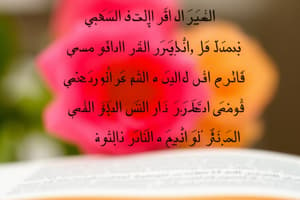Podcast
Questions and Answers
What is the most common metrical pattern used in literature?
What is the most common metrical pattern used in literature?
- dactylic hexameter
- spondaic dimeter
- iambic pentameter (correct)
- trochaic tetrameter
Which of the following feet consists of unstressed followed by stressed syllables?
Which of the following feet consists of unstressed followed by stressed syllables?
- dactyl
- iamb (correct)
- trochee
- anapest
What type of rhyme involves words that look the same but do not sound the same?
What type of rhyme involves words that look the same but do not sound the same?
- internal rhyme
- eye rhyme (correct)
- perfect rhyme
- assonant rhyme
Which form of poetry is defined as a 14-line lyric poem?
Which form of poetry is defined as a 14-line lyric poem?
Which type of stanza consists of eight lines?
Which type of stanza consists of eight lines?
What feature distinguishes dramatic poetry from other genres?
What feature distinguishes dramatic poetry from other genres?
Which of the following describes a long poem that traditionally tells the tales of heroic adventures?
Which of the following describes a long poem that traditionally tells the tales of heroic adventures?
What type of prosody uses the fixed number of stressed syllables as its main criterion?
What type of prosody uses the fixed number of stressed syllables as its main criterion?
Flashcards are hidden until you start studying
Study Notes
Genres of Literature
- The study of genres is referred to as genology.
- Main literary genres include poetry, prose, and drama.
Poetry
-
Rhythm in Poetry
- Quantitative prosody: focuses on long and short syllables.
- Accentual prosody: emphasizes stressed and unstressed syllables with a fixed number of stresses.
- Syllabic prosody: determines rhythm by the number of syllables in a line.
- Accentual-syllable prosody: combines both syllable count and stress count in a line.
- A regular rhythmic pattern is called metre, with the basic unit being a foot.
-
Types of Feet
- Iamb: unstressed + stressed
- Trochee: stressed + unstressed
- Anapest: unstressed + unstressed + stressed
- Dactyl: stressed + unstressed + unstressed
- Spondee: stressed + stressed
-
Based on Number of Feet in a Line
- Monometer: 1 foot
- Dimeter: 2 feet
- Trimeter: 3 feet
- Tetrameter: 4 feet
- Pentameter: 5 feet
- Hexameter: 6 feet
- Heptameter: 7 feet
- Octameter: 8 feet
-
The most common metre in literature is iambic pentameter.
-
Other frequent metrical patterns include ballad metre and blank verse.
-
Free verse is a special poetic form that does not adhere to traditional metre.
-
Rhyme
- Rhyme can be categorized by location:
- End rhyme: occurs at the end of lines.
- Initial rhyme: occurs at the beginning of lines.
- Internal rhyme: occurs within a line.
- Rhyme can also be classified by number and quality:
- Perfect rhymes: exact matches.
- Imperfect rhymes: close but not exact.
- Eye rhymes: similar spelling but different pronunciation.
- Assonant rhymes: repetition of vowel sounds.
- Consonant rhymes: repetition of consonant sounds.
- Rhyme can be categorized by location:
-
Stanza
- A stanza is a unit of several lines, graphically divided from other groups of lines.
Types of Poetry
-
Lyric Poetry
- Ode: a long poem celebrating love and life, originating from ancient Greece.
- Elegy: a long poem often reflecting on tragic events, particularly death.
- Hymn: a poem written to praise God.
- Sonnet: a 14-line lyric poem.
-
Narrative Poetry
- Epic poem: long narrative poems that describe the adventures of great heroes (e.g., The Odyssey, Beowulf).
- Ballad: typically a sad and tragic poem that contains a refrain.
-
Dramatic Poetry
- Common genres include dramatic monologue, dialogue, and opera.
Studying That Suits You
Use AI to generate personalized quizzes and flashcards to suit your learning preferences.




